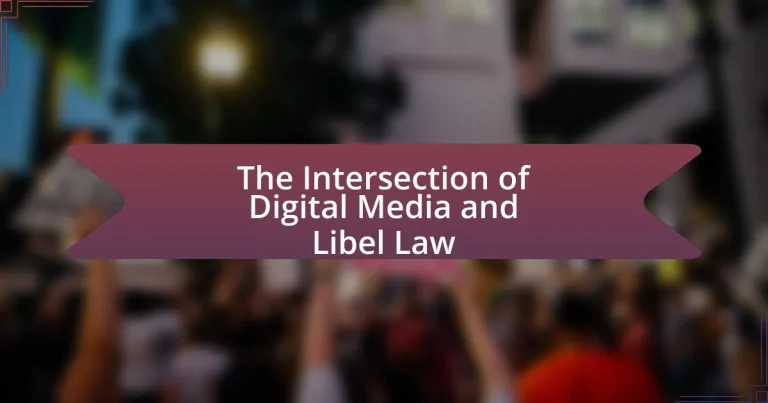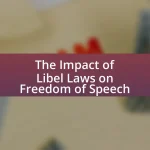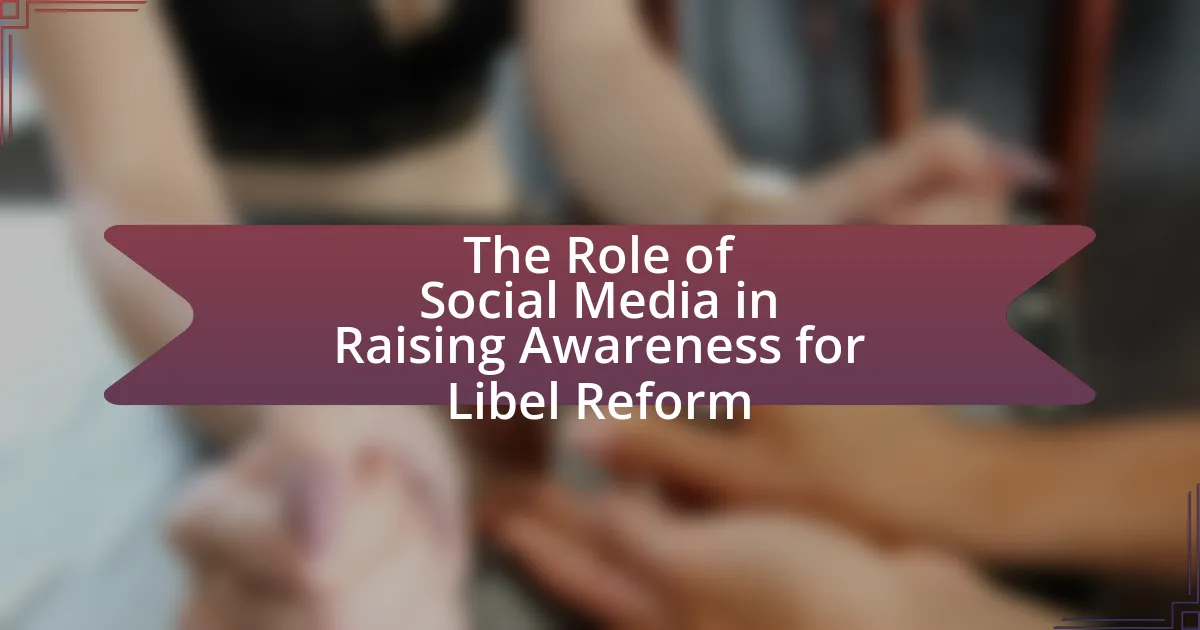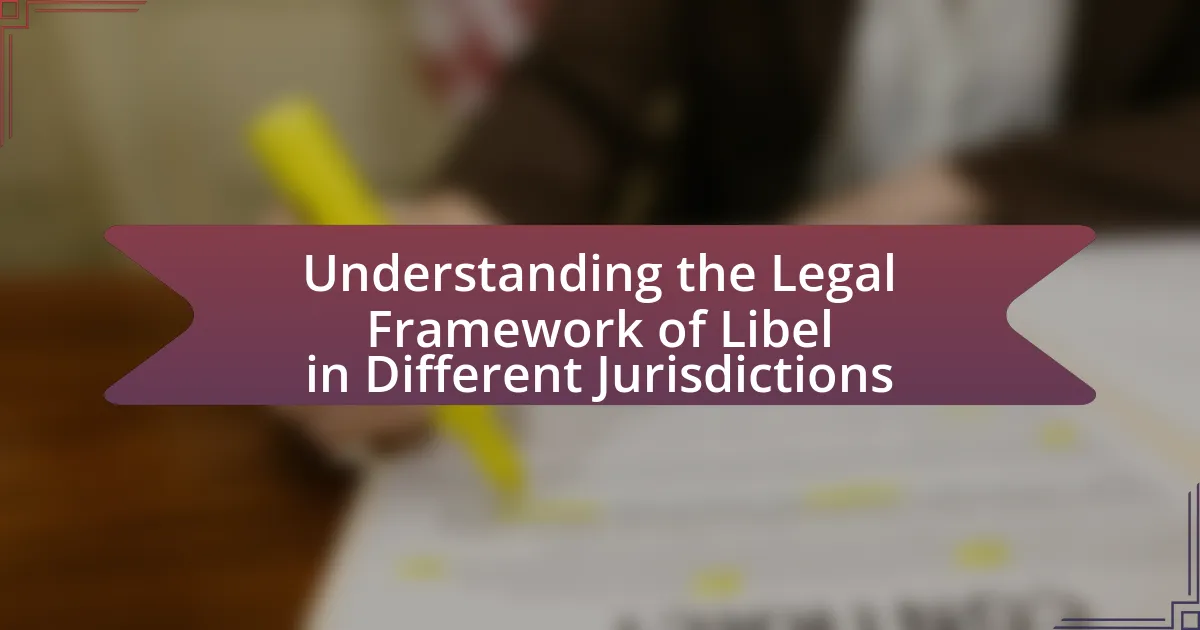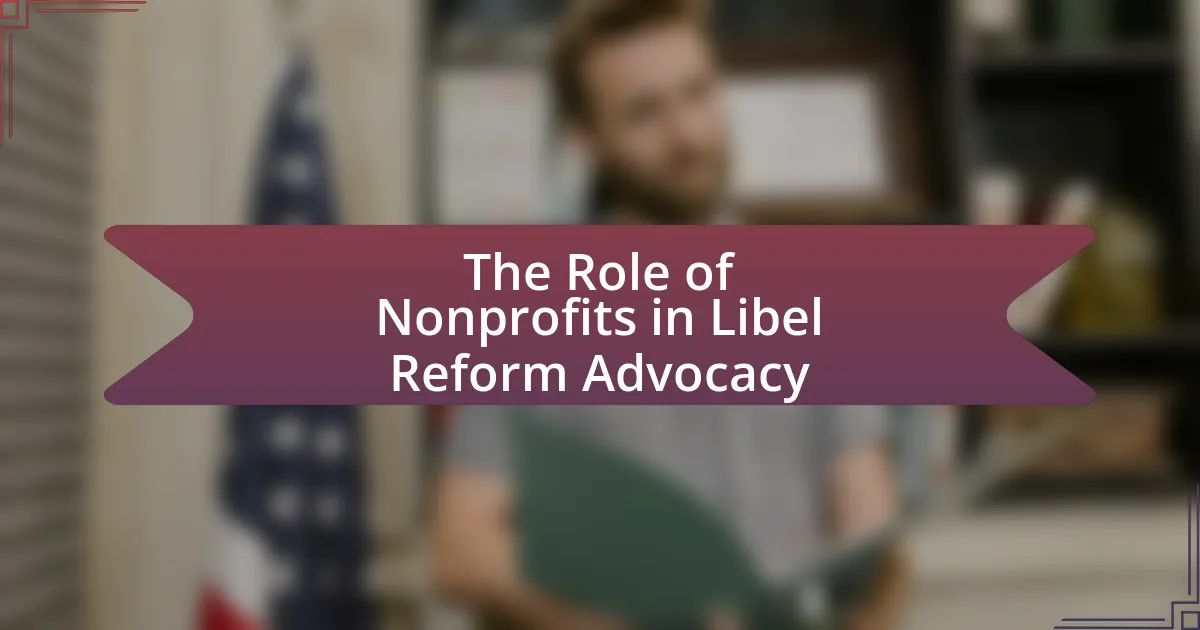The article examines the intersection of digital media and libel law, focusing on how defamation principles apply to online content. It highlights the transformative impact of digital platforms on libel claims, emphasizing the rapid dissemination of information and the challenges of identifying defamatory statements. Key differences between traditional and digital media are discussed, along with the influence of social media on libel claims and the importance of understanding libel law in the digital age. The article also outlines the legal principles governing libel, the evidence required to prove libel in digital contexts, and practical steps individuals can take to navigate these legal complexities.
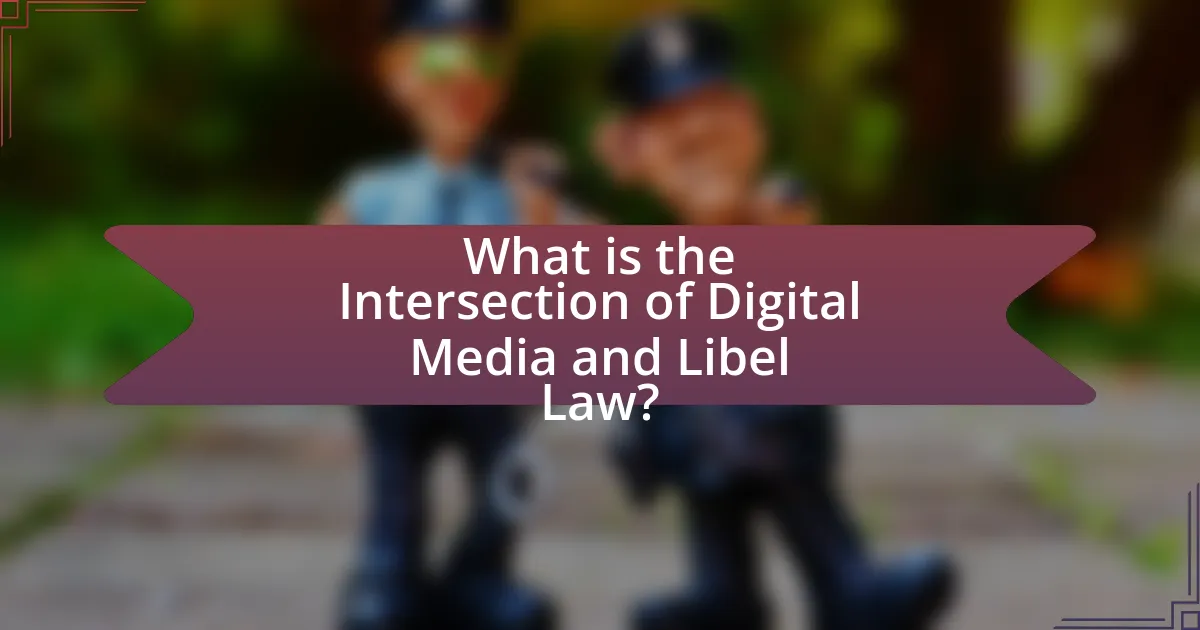
What is the Intersection of Digital Media and Libel Law?
The intersection of digital media and libel law involves the application of defamation principles to online content. Digital media platforms, such as social media and blogs, enable rapid dissemination of information, which can lead to increased instances of libel claims when false statements harm an individual’s reputation. For example, the landmark case of New York Times Co. v. Sullivan established the “actual malice” standard for public figures, which is crucial in evaluating libel cases in the digital age. This legal framework must adapt to the unique challenges posed by digital communication, including the speed of information spread and the difficulty in identifying the original source of defamatory content.
How has digital media transformed the landscape of libel law?
Digital media has significantly transformed the landscape of libel law by increasing the speed and reach of information dissemination, which complicates the identification of defamatory statements. The rise of social media platforms and online publishing has led to a surge in the volume of content shared, making it easier for false information to spread rapidly. For instance, a study by the Pew Research Center found that 64% of Americans believe that false information causes confusion about basic facts, highlighting the challenges in proving libel due to the sheer volume of online discourse. Additionally, the legal standards for libel, such as the requirement for public figures to prove actual malice, have become more complex in the digital age, as the lines between opinion and fact blur in online discussions. This evolution necessitates ongoing adaptations in libel law to address the unique challenges posed by digital media.
What are the key differences between traditional media and digital media in the context of libel?
Traditional media and digital media differ significantly in the context of libel primarily in terms of publication speed, audience reach, and legal standards. Traditional media, such as newspapers and television, typically have longer publication cycles, which allows for more thorough fact-checking and editorial oversight, potentially reducing the risk of libelous statements. In contrast, digital media platforms enable instantaneous publication, often leading to a higher likelihood of disseminating unverified information, which can increase the risk of libel claims.
Additionally, the audience reach of digital media is broader and more global, making it easier for potentially defamatory content to spread rapidly, thus amplifying the impact of any libelous statements. Legal standards also vary; for instance, public figures in the United States must prove “actual malice” to win a libel case, a standard that can be more challenging to meet in the fast-paced digital environment where context and intent may be harder to establish. These differences highlight the evolving challenges of libel law in the digital age.
How do social media platforms influence libel claims?
Social media platforms significantly influence libel claims by facilitating rapid dissemination of information, which can lead to widespread reputational harm. The immediacy and reach of social media allow false statements to spread quickly, increasing the likelihood of individuals or entities facing libel claims. For instance, a study by the Pew Research Center found that 64% of Americans believe that social media has a significant impact on the spread of misinformation, which can directly contribute to libelous statements being made and shared. Additionally, the legal standards for libel can be complicated by the nature of online interactions, where the line between opinion and defamatory statements can become blurred, complicating the process of proving libel in court.
Why is understanding libel law important in the digital age?
Understanding libel law is crucial in the digital age because the rapid dissemination of information online increases the risk of false statements that can harm reputations. In a landscape where social media and online platforms allow for instant sharing, individuals and organizations can be exposed to defamatory content quickly and widely. According to a 2021 study by the Pew Research Center, 64% of Americans have experienced online harassment, highlighting the prevalence of harmful speech. Knowledge of libel law helps individuals navigate these risks, understand their rights, and take appropriate legal action when necessary, ensuring accountability in digital communication.
What are the potential consequences of libel in digital media?
The potential consequences of libel in digital media include legal repercussions, financial damages, and reputational harm. Individuals or organizations found guilty of libel can face lawsuits, resulting in monetary compensation awarded to the victim, which can range from thousands to millions of dollars depending on the severity of the case. Additionally, the spread of false information can lead to significant damage to the reputation of the accused, affecting personal relationships, professional opportunities, and public perception. According to a study by the Media Law Resource Center, the rise of digital platforms has increased the frequency of libel cases, highlighting the urgent need for individuals to understand the implications of their online statements.
How can individuals protect themselves from libel claims online?
Individuals can protect themselves from libel claims online by ensuring that their statements are factual, avoiding false statements about others, and being cautious about sharing opinions that could be interpreted as defamatory. To achieve this, individuals should verify information before posting, use disclaimers when expressing opinions, and consider the context in which statements are made. Legal standards for libel require that a statement be false, damaging, and made with a certain level of fault; therefore, maintaining accuracy and truthfulness significantly reduces the risk of libel claims. Additionally, familiarizing oneself with the laws governing defamation in their jurisdiction can provide further protection against potential claims.
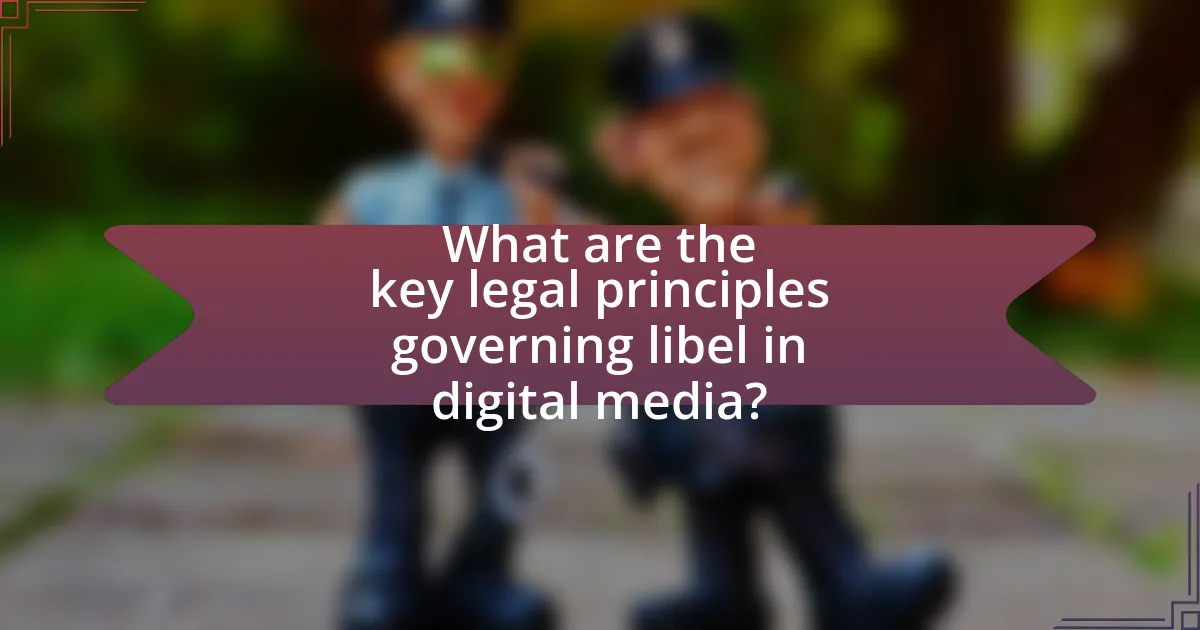
What are the key legal principles governing libel in digital media?
The key legal principles governing libel in digital media include the necessity of proving falsity, the requirement of actual malice for public figures, and the application of the Communications Decency Act’s Section 230, which provides immunity to online platforms for user-generated content. Falsity is essential because a statement must be proven false to be considered libelous; truth is a complete defense against libel claims. For public figures, the Supreme Court’s decision in New York Times Co. v. Sullivan established that they must demonstrate actual malice, meaning the statement was made with knowledge of its falsity or with reckless disregard for the truth. Additionally, Section 230 of the Communications Decency Act protects online platforms from liability for content posted by users, significantly impacting how libel cases are pursued in the digital realm. These principles collectively shape the legal landscape for libel in digital media, balancing free speech with protection against defamation.
What constitutes libel in the context of digital media?
Libel in the context of digital media constitutes the publication of false statements that damage an individual’s reputation. Digital platforms, such as social media, blogs, and websites, can facilitate the rapid dissemination of these statements, making it easier for harmful content to reach a wide audience. For a statement to be considered libelous, it must be presented as a fact, be untrue, and cause harm to the subject’s reputation. Legal precedents, such as the case of New York Times Co. v. Sullivan (1964), establish that public figures must also prove actual malice, meaning the statement was made with knowledge of its falsity or with reckless disregard for the truth.
How do definitions of libel vary between jurisdictions?
Definitions of libel vary significantly between jurisdictions, primarily influenced by local laws, cultural norms, and judicial interpretations. For instance, in the United States, libel is defined under common law and requires proof of actual malice for public figures, as established in the landmark case New York Times Co. v. Sullivan (1964). Conversely, in the United Kingdom, the Defamation Act 2013 simplifies the process for claimants, focusing on whether the statement has caused serious harm, without the need to prove malice. Additionally, some jurisdictions, like Canada, incorporate a defense of responsible communication on matters of public interest, which further complicates the libel landscape. These variations reflect differing balances between protecting reputation and upholding freedom of expression across legal systems.
What role does intent play in determining libel cases?
Intent plays a crucial role in determining libel cases, as it influences whether a statement is deemed defamatory and whether the defendant can be held liable. In libel law, the plaintiff must typically prove that the defendant acted with actual malice or negligence, depending on the status of the plaintiff (public figure or private individual). Actual malice requires showing that the defendant knew the statement was false or acted with reckless disregard for the truth. This standard is established in the landmark case New York Times Co. v. Sullivan (1964), which set the precedent that public officials must prove actual malice to win a libel suit. Therefore, intent directly affects the outcome of libel cases by determining the level of fault required for liability.
How do courts evaluate libel cases involving digital media?
Courts evaluate libel cases involving digital media by applying traditional libel law principles while considering the unique characteristics of online platforms. They assess whether the statement in question is false, defamatory, and made with the requisite degree of fault, typically negligence or actual malice, depending on the status of the plaintiff. Courts also examine the context in which the statement was made, including the medium of publication, the audience, and the potential for harm. For instance, in the landmark case of New York Times Co. v. Sullivan, the U.S. Supreme Court established that public figures must prove actual malice to succeed in libel claims, a standard that continues to influence digital media cases. Additionally, courts may consider the role of user-generated content and the protections offered by Section 230 of the Communications Decency Act, which shields platforms from liability for content created by third parties.
What standards do courts use to assess damages in libel cases?
Courts assess damages in libel cases primarily using the standards of actual malice and negligence, depending on the status of the plaintiff. In cases involving public figures, the plaintiff must demonstrate actual malice, meaning the defendant knew the statement was false or acted with reckless disregard for the truth. For private individuals, the standard is typically negligence, requiring the plaintiff to show that the defendant failed to exercise reasonable care in verifying the truth of the statement. This distinction is rooted in the Supreme Court’s decision in New York Times Co. v. Sullivan, which established the actual malice standard to protect free speech while balancing the need to address false statements.
How do precedents from traditional media influence digital libel cases?
Precedents from traditional media significantly influence digital libel cases by establishing legal standards for defamation that are applied to online platforms. Courts often reference established principles from traditional media, such as the requirement for actual malice in cases involving public figures, as seen in the landmark case New York Times Co. v. Sullivan (1964). This case set a high bar for proving libel, which continues to shape how digital libel cases are adjudicated, ensuring that similar standards of proof are maintained across both traditional and digital media. Additionally, the application of these precedents helps to clarify the responsibilities of digital publishers and social media platforms in moderating content, as they are often held to the same standards as traditional media outlets.
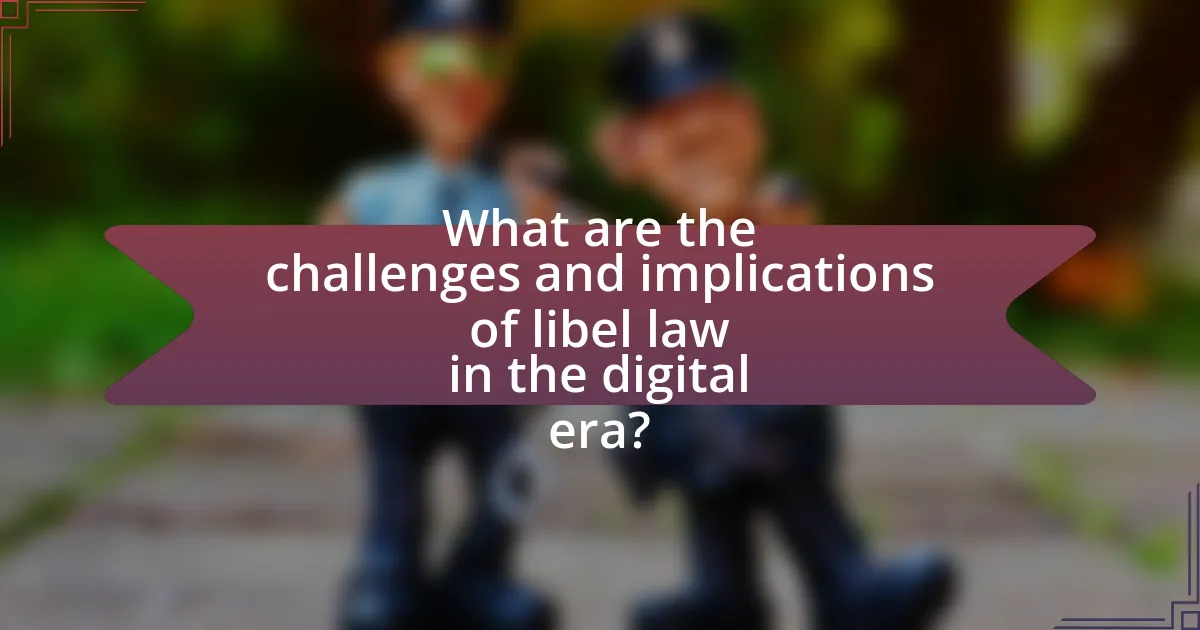
What are the challenges and implications of libel law in the digital era?
The challenges and implications of libel law in the digital era include the rapid dissemination of information, the difficulty in identifying responsible parties, and the varying standards of proof across jurisdictions. Digital platforms enable information to spread quickly, making it challenging for individuals to control their reputations and for legal systems to respond effectively. Additionally, the anonymity of online users complicates the identification of those who may be liable for defamatory statements, leading to difficulties in enforcing libel laws. Furthermore, different countries have different thresholds for what constitutes libel, which can create inconsistencies in legal outcomes for similar cases. For instance, the United States employs a higher standard for public figures to prove libel compared to many other countries, which can lead to confusion and inequity in international cases.
What are the unique challenges faced by plaintiffs in digital libel cases?
Plaintiffs in digital libel cases face unique challenges primarily due to the complexities of proving defamation in an online context. One significant challenge is establishing the identity of the defendant, as anonymity is prevalent on digital platforms, making it difficult to hold individuals accountable. Additionally, plaintiffs must demonstrate that the statements made were false and damaging, which can be complicated by the rapid spread of information and the potential for context to alter perceptions of the statements. The burden of proof often lies heavily on the plaintiff, requiring substantial evidence to support claims of harm, which can be difficult to quantify in the digital realm. Furthermore, the legal standards for public figures are more stringent, necessitating proof of actual malice, which adds another layer of difficulty for plaintiffs. These challenges are compounded by the evolving nature of digital communication and the varying laws across jurisdictions, making it essential for plaintiffs to navigate a complex legal landscape.
How does anonymity online complicate libel claims?
Anonymity online complicates libel claims by making it difficult to identify the individuals responsible for defamatory statements. When users post comments or content under pseudonyms or anonymously, plaintiffs face challenges in establishing the identity of the defendant, which is crucial for pursuing legal action. According to a study by the Pew Research Center, 70% of internet users have witnessed online harassment, often from anonymous sources, highlighting the prevalence of anonymity in harmful speech. This lack of accountability can deter victims from filing claims, as the legal process requires proving the identity of the alleged libeler, which can be a complex and resource-intensive endeavor.
What evidence is typically required to prove libel in digital contexts?
To prove libel in digital contexts, a plaintiff typically needs to provide evidence that includes the publication of a false statement, identification of the plaintiff, fault on the part of the publisher, and damages. The publication must be shown to have been made to a third party, and the statement must be demonstrably false. Identification can be established if the statement refers to the plaintiff, either directly or indirectly. The fault standard varies; public figures must show actual malice, while private individuals need to demonstrate negligence. Finally, the plaintiff must prove that the false statement caused harm, which can include reputational damage or economic loss. These elements align with established legal standards, such as those outlined in the landmark case New York Times Co. v. Sullivan, which set the precedent for libel cases involving public figures.
How can digital media companies mitigate libel risks?
Digital media companies can mitigate libel risks by implementing robust editorial standards and fact-checking processes. Establishing clear guidelines for content creation ensures that information is verified before publication, reducing the likelihood of disseminating false statements. Additionally, training staff on libel laws and the importance of accuracy in reporting can further minimize risks. According to a study by the Media Law Resource Center, companies that adopt comprehensive training programs experience a significant decrease in libel claims. Furthermore, maintaining a transparent correction policy allows companies to address any inaccuracies promptly, which can serve as a defense in libel cases.
What best practices should digital platforms implement to avoid libel claims?
Digital platforms should implement robust content moderation policies to avoid libel claims. These policies should include clear guidelines for user-generated content, ensuring that all posts are reviewed for potential defamatory statements before publication. Additionally, platforms should provide users with tools to report harmful content and establish a transparent process for addressing such reports.
Research indicates that platforms with proactive moderation and user education on defamation laws experience fewer legal challenges. For instance, a study by the Pew Research Center found that platforms that actively engage in content moderation reduce the prevalence of harmful misinformation, which can lead to libelous claims. By prioritizing these practices, digital platforms can significantly mitigate the risk of facing libel lawsuits.
How can content moderation policies impact libel liability?
Content moderation policies can significantly impact libel liability by determining the extent to which platforms are responsible for user-generated content. When platforms implement strict moderation policies, they may reduce their exposure to libel claims by actively monitoring and removing defamatory content, thereby demonstrating a commitment to preventing harm. Conversely, lax moderation can increase liability, as platforms may be seen as negligent in addressing harmful statements. For instance, the Communications Decency Act in the United States provides some immunity to online platforms for user content, but this protection can be undermined if a platform is found to have failed in its moderation duties, as seen in cases where courts have ruled against platforms for not taking action on clearly defamatory material.
What practical steps can individuals take to navigate libel law in digital media?
Individuals can navigate libel law in digital media by understanding the legal definitions of libel, verifying information before sharing, and maintaining a clear distinction between opinion and fact. Understanding that libel involves false statements that damage a person’s reputation is crucial; this knowledge helps individuals recognize potentially libelous content. Verifying information through credible sources before posting reduces the risk of disseminating false claims, which can lead to legal repercussions. Additionally, individuals should express opinions clearly as opinions are generally protected under free speech laws, provided they do not assert false facts. These steps are essential in minimizing the risk of libel claims in the digital landscape, where information spreads rapidly and can have significant consequences.
